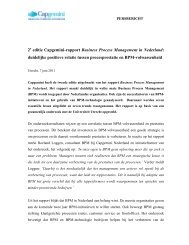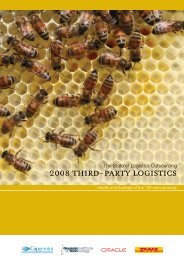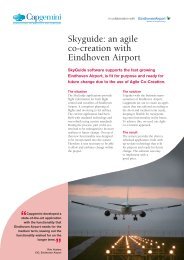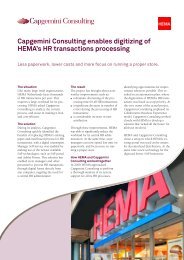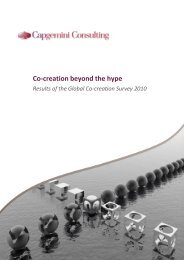IT transformations - Capgemini Consulting Nederland
IT transformations - Capgemini Consulting Nederland
IT transformations - Capgemini Consulting Nederland
Create successful ePaper yourself
Turn your PDF publications into a flip-book with our unique Google optimized e-Paper software.
“<br />
Companies<br />
should strive<br />
to make<br />
architectural<br />
thinking<br />
part of the<br />
organization’s<br />
fabric<br />
”<br />
making executives think more<br />
creatively about how to add value<br />
continuously.<br />
Have the courage to change routines<br />
Adapting to sector changes requires<br />
courage; employees will need to<br />
revisit old habits. Executives should<br />
be able to revisit practices and<br />
priorities as business models change.<br />
Be outward-looking<br />
Within an organization, discussions<br />
can become introspective. Companies<br />
can combat this tendency by<br />
redefining rules and roles of the<br />
firm, revisiting how they connect<br />
with others. To do so, they need to<br />
link internal responsibilities and<br />
accountability with outward-looking<br />
objectives.<br />
Articulate vision outside the<br />
organization<br />
With alliances forming in record<br />
numbers, it is crucial to foster<br />
employee skills that permit seeking<br />
new sources of collaborative value<br />
and support the company’s vision.<br />
Selection and promotion criteria must<br />
recognize these skills.<br />
Be strategic, not just nice<br />
Managers might believe that the<br />
company’s external orientation means<br />
creating many relationships with<br />
outside partners, increasing alliances<br />
and so on. But it’s important to be<br />
strategic and establish a clear sense<br />
of why a relationship exists, how it<br />
is managed, and the benefits that are<br />
expected of it.<br />
Keep a larger picture in mind<br />
Managers often focus on generating<br />
volume. This must be tempered<br />
by a more strategic sense of how<br />
this can actually improve the<br />
company’s position. This won’t<br />
happen automatically: it requires<br />
reinforcement, monitoring, incentives,<br />
training, and effort.<br />
These priorities must be woven<br />
into the organization’s fabric. The<br />
real challenge is integrating these<br />
outward-looking insights into daily<br />
operations. Changing a company’s<br />
culture is no mean feat, but doing<br />
so can give these ideas real traction.<br />
One way to make companies more<br />
externally focused is to redesign,<br />
opening up the “pores” along the<br />
value chain to energize the firm<br />
and make it more aware of different<br />
opportunities. This might redress the<br />
problem of introspection, inherent<br />
in traditional vertically integrated<br />
companies. This same principle<br />
underpins many of the benefits of<br />
several “open” structures emerging of<br />
late: it allows companies to be more<br />
adaptable. If we add “architectural<br />
cunning” to this more extrovert<br />
orientation, companies can thrive<br />
even in challenging settings. Such<br />
architectural thinking is an integral<br />
part of organizations’ re-think of their<br />
own “playscript”— of the ways in<br />
which they can add and capture value<br />
in a rapidly shifting environment 9 .<br />
Conclusion<br />
Shaping the sector in which a<br />
company operates and seizing new<br />
opportunities to win control of the<br />
industry’s architecture is increasingly<br />
becoming a priority. In a shifting<br />
landscape a “guerrilla” mentality is<br />
key to success. Companies need to<br />
be proactive in shaping their sector<br />
and ensure that their preferred<br />
vision and architecture can be<br />
accepted and become dominant.<br />
Alternatively, they can seek to<br />
improve their position within an<br />
existing architecture. As globalization,<br />
<strong>IT</strong>, and deregulation facilitate<br />
disintegration and “re-combinations”,<br />
as options and trading partners grow<br />
exponentially and alliances hit alltime<br />
high levels, companies need<br />
to take a strategic approach. With<br />
new options come new challenges<br />
and, with opportunities appearing<br />
9 Michael G. Jacobides, Strategy Tools for a Shifting Landscape, Harvard Business Review, pp. 76-85, Vol. 88, No. 1,<br />
January-February 2010 or ibid,The Play’s the Thing, Business Strategy Review, pp. 58-63, Vol. 21, Issue 2, 2010.<br />
90



